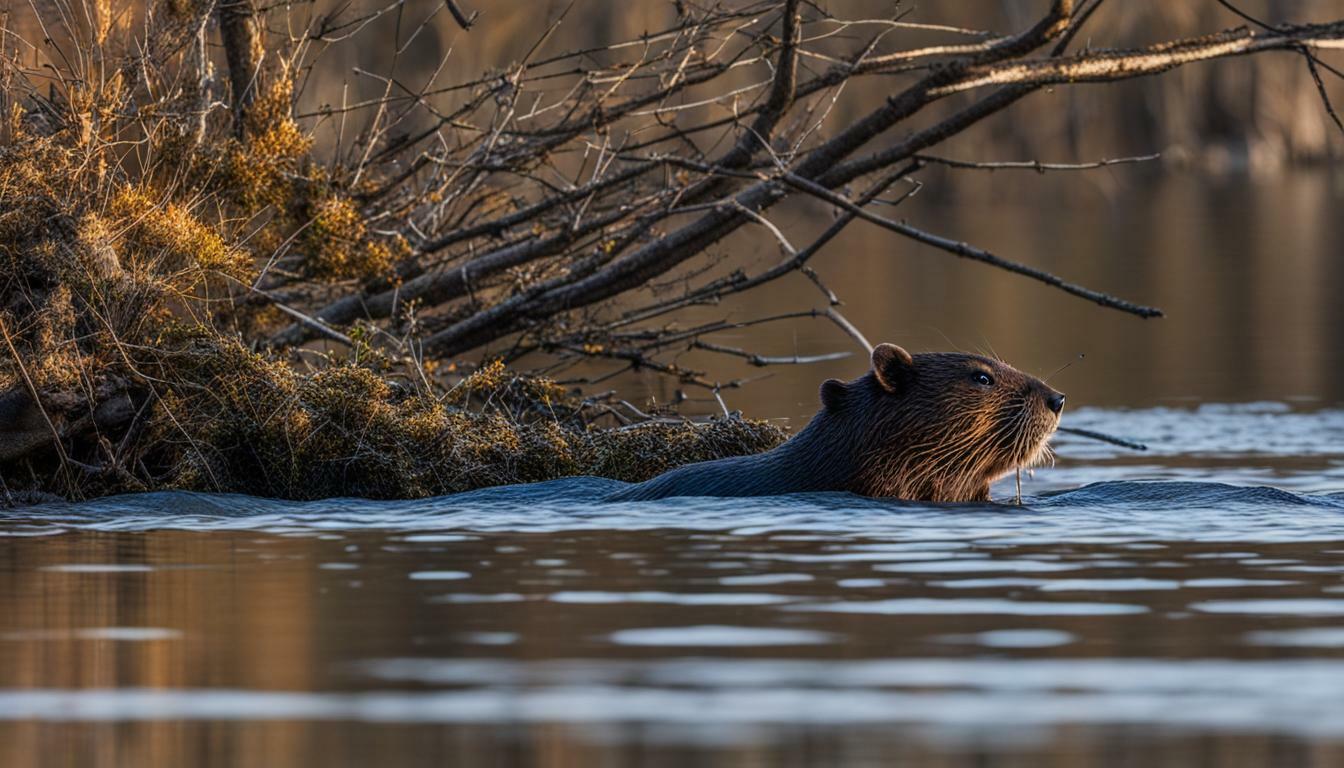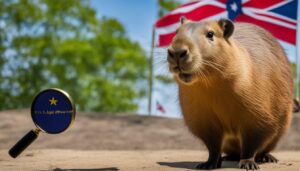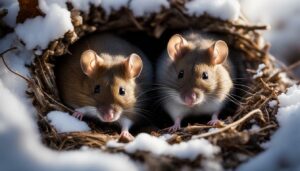Beavers, industrious creatures known for their ability to construct complex dams and lodges, do indeed have natural predators that play a crucial role in their ecosystem. These fascinating creatures are not immune to the pressures of predation, and a variety of animals pose a threat to their survival. Let’s explore the world of beaver predators and their impact on these remarkable creatures.
Key Takeaways:
- Beavers have natural predators that play a vital role in their ecosystem.
- The North American beaver faces threats from fishers, coyotes, hawks, bears, otters, lynx, eagles, mountain lions, owls, wolverines, and wolves.
- Eurasian beavers found in Asia and Europe are hunted by red foxes, brown bears, lynx, and Eurasian wolves.
- Humans also pose a significant threat to beavers through hunting for their skin and fur.
- Other predators include owls, bears, mountain lions, foxes, coyotes, otters, wolves, and wolverines.
Now, let’s delve deeper into the world of beaver predators and the intricate relationship between these creatures and their natural enemies.
Understanding Beavers and Their Habitat
Before delving into the topic of beaver predators, it’s essential to understand the role beavers play in their ecosystem and the significance of maintaining a balanced environment. Beavers are known as nature’s engineers, creating intricate systems of dams and lodges that serve multiple purposes.
These industrious creatures have a remarkable ability to shape their environment, creating wetlands that provide essential habitat for a wide variety of plant and animal species. The dams they construct help regulate water flow, reducing the risk of flooding during heavy rainfall and maintaining consistent water levels during dry periods.
Furthermore, the wetlands created by beavers act as natural filters, improving water quality by trapping sediment and promoting the growth of beneficial vegetation. These wetlands also serve as crucial breeding grounds for fish and amphibians, contributing to the overall biodiversity of the area.
| Beaver Ecosystem Benefits | Beaver Ecosystem Balance |
|---|---|
| Regulate water flow and reduce flooding | Preserve the delicate balance of water and land ecosystems |
| Promote the growth of beneficial vegetation | Provide habitat for a wide range of plant and animal species |
| Improve water quality by trapping sediment | Contribute to the overall biodiversity of the area |
The Delicate Balance of Beaver Ecosystems
Beavers, through their ecosystem engineering, have a profound impact on the balance of their habitats. By creating wetlands and modifying waterways, they influence the flow and retention of water, which, in turn, affects vegetation, wildlife, and water quality. These changes can have far-reaching effects on the landscape and its inhabitants, leading to complex interactions within the ecosystem.
For example, when beavers build dams, they create ponds and wetlands that attract numerous animal species, including waterfowl, fish, amphibians, and insects. These freshwater habitats provide essential resources for these creatures, such as shelter, food, and breeding grounds. The increased biodiversity within beaver ecosystems contributes to the overall health and resilience of the environment.
However, maintaining a balance is crucial. Without careful management, beavers can sometimes negatively impact their surroundings by flooding agricultural lands or blocking important waterways. Finding ways to mitigate these potential conflicts is essential for ensuring both the well-being of beavers and the sustainability of their ecosystems.
North American Beaver Predators
In North America, where the North American beaver resides, there are several predators that view beavers as a potential food source, leading to a constant struggle for survival. These predators include fishers, coyotes, hawks, bears, otters, lynx, eagles, mountain lions, owls, wolverines, and wolves.
The fisher, a member of the weasel family, is known for its agility and ability to climb trees, making it a formidable predator for beavers. Coyotes, on the other hand, are highly adaptable and have been known to target beavers when other food sources are scarce. Hawks and eagles, with their keen eyesight and powerful talons, pose a threat to beavers, especially when they are swimming near the water’s surface.
Bears, otters, lynx, mountain lions, owls, wolverines, and wolves also prey on beavers. These apex predators have the strength and hunting skills required to catch and consume these large rodents. While each predator may have its own preferred hunting technique, they all contribute to the delicate balance of nature by keeping beaver populations in check.
| Predator | Habitat | Hunting Technique |
|---|---|---|
| Fisher | Forests and wetlands | Tree climbing |
| Coyote | Varying habitats | Adaptability and opportunistic hunting |
| Hawk | Open areas with water sources | Aerial hunting |
| Bear | Forests and wetlands | Opportunistic hunting and scavenging |
| Otter | Rivers, lakes, and wetlands | Aquatic hunting |
| Lynx | Forests and tundra | Stealthy stalking |
| Eagle | Wide range of habitats | Aerial hunting and diving |
| Mountain Lion | Forests and mountains | Stealthy stalking and ambush |
| Owl | Forests and open areas | Nocturnal hunting |
| Wolverine | Arctic and subarctic regions | Powerful pursuit and scavenging |
| Wolf | Wide range of habitats | Pack hunting and cooperation |
It is important to note that these predators play a crucial role in regulating beaver populations and maintaining a healthy ecosystem. Without them, the beaver population could grow unchecked, leading to overpopulation and the potential depletion of vital resources.
However, human activities, such as hunting and habitat destruction, have also posed a significant threat to beavers over the years. Conservation efforts and effective predator control measures are essential in ensuring the survival of beavers and maintaining the delicate balance of their ecosystems.
Eurasian Beaver Predators
Across Asia and Europe, where the Eurasian beaver dwells, a separate set of predators poses a constant challenge to their survival. Red foxes, brown bears, lynx, and Eurasian wolves are among the primary predators that prey upon these fascinating creatures. These predators have evolved intricate hunting strategies to capture beavers and exploit their resources.
The red fox, known for its cunning and agility, is a formidable predator of the Eurasian beaver. Armed with sharp teeth and strong jaws, they can quickly overpower a beaver and feast upon its flesh. Brown bears, although primarily omnivorous, are opportunistic predators that will not hesitate to prey upon beavers when given the chance. With their immense strength and size, they can easily overpower beavers and consume them as part of their varied diet.
Lynx, with their stealth and sharp senses, are skilled hunters that pose a significant threat to the Eurasian beaver population. These agile felines are capable of stalking and ambushing beavers, utilizing their powerful paws and sharp claws to deliver a swift and lethal attack. Eurasian wolves, known for their strong pack dynamics and cooperative hunting methods, also target beavers for sustenance. Their pack mentality allows them to effectively take down beavers, ensuring a successful hunt and a valuable food source for the entire pack.
| Predators | Primary Prey |
|---|---|
| Red foxes | Eurasian beavers |
| Brown bears | Eurasian beavers |
| Lynx | Eurasian beavers |
| Eurasian wolves | Eurasian beavers |
The existence of these predators in Eurasian beaver habitats highlights the complex relationship between these creatures and their natural enemies. While beavers face significant threats from these predators, they have also evolved mechanisms to defend themselves, such as constructing elaborate dams and lodges to create protective barriers against their adversaries. This delicate balance between predation and defense is crucial for the survival and sustainability of beaver populations across Asia and Europe.
Human Threat to Beavers
Unfortunately, humans have played a role in the decline of beaver populations due to hunting and the need to manage predation in certain areas. Historically, beavers were hunted for their valuable fur, which led to a significant decrease in their population. Although hunting regulations and conservation efforts have helped protect beavers in recent years, human activities still pose a threat to these fascinating creatures.
In order to control beaver populations and mitigate their impact on human infrastructure, predator control measures are sometimes implemented. These measures aim to minimize damage caused by beaver activity, such as flooding and the destruction of trees. However, it is important to strike a balance between managing beaver predation and protecting the overall population.
Table 1: Additional Predators of Beavers
| Predator | Threat Level |
|---|---|
| Owls | Medium |
| Bears | Medium |
| Mountain Lions | High |
| Foxes | Low |
| Coyotes | Medium |
| Otters | High |
| Wolves | High |
| Wolverines | High |
Source: Beaver Conservation Society
It is crucial to acknowledge the value of beavers and their ecosystems in order to implement effective conservation strategies. Beavers play a vital role in maintaining ecological balance by creating wetlands, which provide habitat for various species and improve water and land management. By understanding the complex relationship between beavers and their predators, we can work towards a sustainable future that ensures the survival of these remarkable animals.
Other Predators of Beavers
In addition to the more commonly known predators, such as bears and wolves, there are several other animals that can pose a risk to beavers in their natural habitats. These lesser-known predators include owls, mountain lions, foxes, coyotes, otters, and wolverines. While they may not be as widely discussed, their presence can have a significant impact on the beaver population.
Owls, with their silent flight and sharp talons, are skilled hunters that can swoop down on unsuspecting beavers resting near the water’s edge. Mountain lions, known for their stealth and agility, can stalk beavers as they venture out of their lodges. Foxes, coyotes, and otters are opportunistic predators that will seize any chance to prey upon young or weakened beavers.
Wolverines, with their powerful jaws and sharp teeth, have been observed raiding beaver lodges for food. These formidable predators are known to be highly skilled at breaking through the beaver’s elaborate dam systems and extracting their prey. Their ability to adapt to different environments and climates makes them a formidable threat to beavers across various regions.
| Other Predators of Beavers |
|---|
| Owls |
| Mountain Lions |
| Foxes |
| Coyotes |
| Otters |
| Wolverines |
While these predators may not be as well-known as others, their role in the natural ecosystem cannot be underestimated. By preying on beavers, they help maintain a balance in the population and prevent overpopulation, which can lead to negative consequences for other species and the environment as a whole.
Understanding the complex web of predator-prey relationships is crucial in our efforts to conserve beaver populations and ensure the health of their ecosystems. By implementing effective conservation strategies and managing predator populations responsibly, we can strive for a sustainable future where beavers and their predators harmoniously coexist.
Managing Beaver Predation
Finding ways to manage beaver predation is crucial in order to maintain healthy beaver populations while ensuring the ecological balance of their habitats. With a range of predators posing a threat to these fascinating creatures, it is important to implement effective strategies for conservation and predator control.
One approach to managing beaver predation is through the promotion of beaver conservation efforts. By creating protected areas or reserves where beavers can thrive undisturbed, their populations can be safeguarded from excessive predation. These conservation areas can provide a safe haven for beavers, allowing them to play their vital role in maintaining ecosystem balance.
Another aspect of managing beaver predation involves implementing predator control measures. This can include the identification and monitoring of key predators in beaver habitats, such as fishers, coyotes, and bears. By understanding the behavior and patterns of these predators, it becomes possible to develop targeted strategies to minimize their impact on beaver populations.
In some cases, it may be necessary to use non-lethal methods of predator control, such as the installation of fencing or deterrents to keep predators away from beaver colonies. These measures can help reduce predation and create a safer environment for beavers to thrive. However, it is important to strike a balance between managing predation and promoting the natural ecosystem dynamics, as predators play a crucial role in maintaining a healthy and balanced environment.
| Predators of Beavers |
|---|
| Fishers |
| Coyotes |
| Bears |
| Otters |
| Lynx |
| Eagles |
| Mountain lions |
| Owls |
| Wolverines |
| Wolves |
In conclusion, managing beaver predation is essential for the conservation of these remarkable creatures and the preservation of their habitats. Through a combination of beaver conservation efforts and carefully implemented predator control measures, we can ensure the longevity of healthy beaver populations and maintain the delicate ecological balance they contribute to.
The Importance of Beaver Ecosystems
Beavers, as ecosystem engineers, have a profound influence on their surroundings, shaping the landscape and creating habitats that benefit various other species. Their ability to construct dams and lodges not only provides them with shelter and protection, but also creates a complex network of wetlands that serve as crucial ecosystems. These wetlands play a vital role in maintaining the balance of our natural environment.
One of the key contributions of beaver ecosystems is their impact on water management. By building dams, beavers create ponds and slow-moving streams that act as natural reservoirs, helping to regulate water flow and prevent flooding. These structures also aid in water filtration, trapping sediment and pollutants, resulting in cleaner and healthier water for both humans and wildlife.
| Benefit of Beaver Ecosystems | Description |
|---|---|
| Biodiversity | Beaver-created wetlands support a diverse array of plant and animal species, providing vital habitat for amphibians, waterfowl, fish, and insects. |
| Carbon Sequestration | The wetland vegetation facilitated by beavers helps to store carbon, reducing greenhouse gas emissions and mitigating climate change. |
| Erosion Control | Beaver dams stabilize stream banks and reduce erosion, preventing sediment from entering waterways and preserving water quality. |
| Habitat Creation | The diverse habitats formed by beaver ponds support a range of wildlife species, contributing to overall ecosystem health and resilience. |
Moreover, these wetlands provide essential habitats for various species. The slow-moving water and flooded areas created by beaver activity serve as ideal breeding grounds for amphibians, nesting sites for waterfowl, and feeding areas for fish. The abundance of vegetation found in beaver wetlands also attracts a wide range of insects, which in turn provide a vital food source for birds and other small animals.
In summary, the ecological impacts of beavers cannot be overstated. Their engineering prowess contributes to diverse and thriving ecosystems, benefiting numerous plant and animal species. By recognizing the significance of beavers and their ability to shape the environment, we can work towards conserving these unique creatures and preserving the delicate balance of our natural world.
The Complex Relationship between Beavers and Predators
The interaction between beavers and predators is a complex dance, with predation serving as both a necessary check on beaver populations and a potential threat to their survival. Natural enemies of beavers play a crucial role in maintaining the delicate balance of their ecosystems, ensuring that the beaver population remains in check and their habitats remain healthy.
Beavers, being ecosystem engineers, dramatically alter their environment by building dams and creating wetlands. These modifications attract a variety of predators that rely on the abundance of water and the resources it provides. Predators such as fishers, coyotes, hawks, bears, otters, lynx, eagles, mountain lions, owls, wolverines, and wolves view beavers as a potential source of food, drawing them into the beaver’s domain.
However, while predators serve as a natural control on beaver populations, they can also pose a threat to the survival of these industrious creatures. The delicate balance between predator and prey can be disrupted when predator populations increase beyond sustainable levels or when human activities interfere with the natural dynamics of the ecosystem. As humans hunt beavers for their valuable skin and fur, the population of these animals can decline, disrupting the balance of predator-prey relationships.
The Role of Conservation and Management
Conservation efforts play a vital role in maintaining the balance between beavers and their natural enemies. By protecting beaver habitats and implementing effective predator control measures, we can ensure the survival of both predators and beavers within the ecosystem. Striking this balance is essential to preserve the ecological benefits provided by beavers, such as their ability to create wetlands, improve water quality, and regulate water flow.
| Predators of North American Beavers | Predators of Eurasian Beavers | Other Predators |
|---|---|---|
| • Fishers | • Red foxes | • Owls |
| • Coyotes | • Brown bears | • Bears |
| • Hawks | • Lynx | • Mountain lions |
| • Bears | • Eurasian wolves | • Foxes |
| • Otters | • Coyotes | |
| • Lynx | • Otters | |
| • Eagles | • Wolves | |
| • Mountain lions | • Wolverines |
Source: Compiled from research on beaver predators
Conclusion
In conclusion, beavers indeed have natural predators, and understanding their role in the ecosystem is essential for ensuring the conservation of these remarkable creatures. The North American beaver population faces threats from fishers, coyotes, hawks, bears, otters, lynx, eagles, mountain lions, owls, wolverines, and wolves. Eurasian beavers, found in Asia and Europe, are hunted by red foxes, brown bears, lynx, and Eurasian wolves. Humans also pose a significant threat to beavers, hunting them for their valuable fur. Additionally, other predators such as owls, bears, mountain lions, foxes, coyotes, otters, wolves, and wolverines contribute to the challenges faced by these creatures.
Conservation efforts are vital to protect beavers and their habitats. By safeguarding these remarkable creatures, we can maintain the delicate balance of our ecosystems. Managing beaver predation is crucial, as it involves finding ways to strike a balance between protecting beavers and addressing the control of their natural enemies. This delicate relationship between beavers and their predators emphasizes the interconnectedness of all species in the ecosystem, highlighting the importance of sustainable management.
Beavers play a vital role in our ecosystems as ecosystem engineers. Through their dam-building activities, they create complex wetland habitats that benefit numerous plant and animal species. This contributes to water and land management, helping to prevent flooding, filter pollutants, and increase biodiversity. By recognizing the importance of beaver ecosystems, we can promote their conservation and protect the invaluable services they provide to our environment.
In conclusion, the conservation of beavers is crucial to maintain ecological balance. This involves addressing the threat posed by human hunting and implementing effective strategies for managing beaver predation. By ensuring the survival and well-being of beavers and their natural predators, we can preserve these remarkable creatures and the intricate ecosystems they inhabit for future generations to enjoy.
FAQ
Do beavers have natural predators?
Yes, beavers do have natural predators. The North American beaver is preyed upon by fishers, coyotes, hawks, bears, otters, lynx, eagles, mountain lions, owls, wolverines, and wolves. Eurasian beavers, found in Asia and Europe, are hunted by red foxes, brown bears, lynx, and Eurasian wolves. Humans also pose a threat to both species, as they hunt them for their skin and fur. Other predators include owls, bears, mountain lions, foxes, coyotes, otters, wolves, and wolverines.




